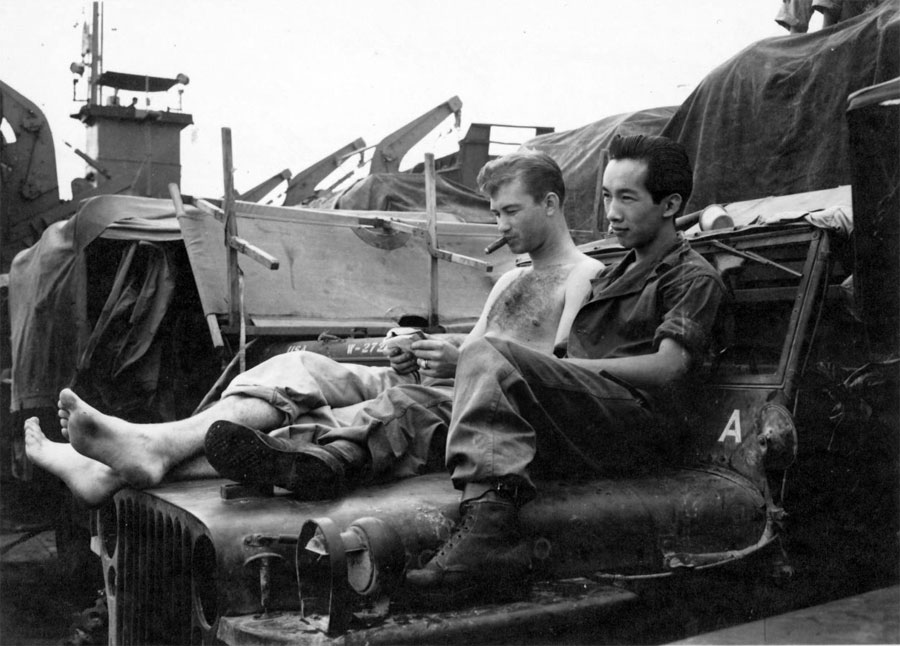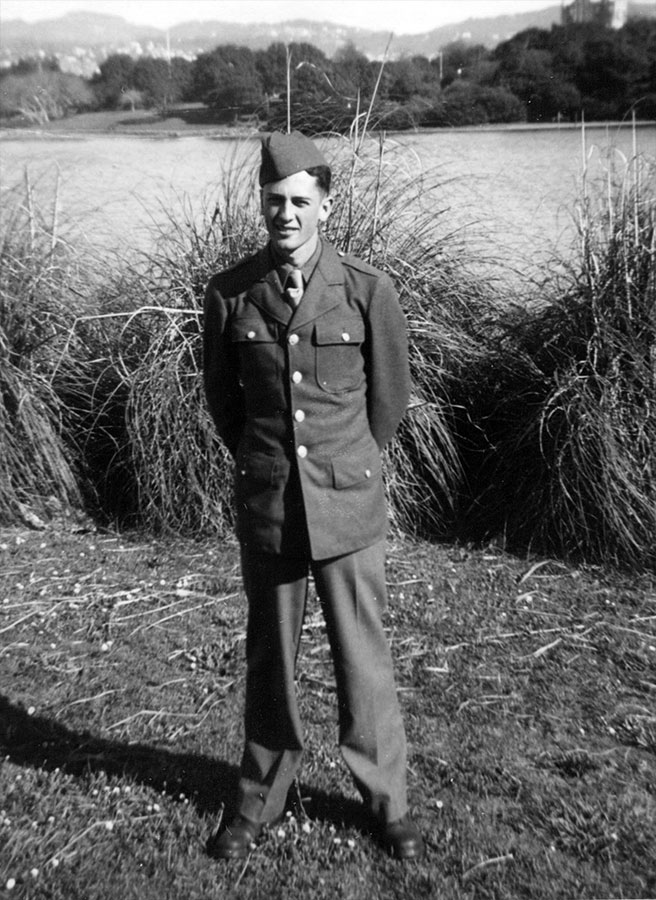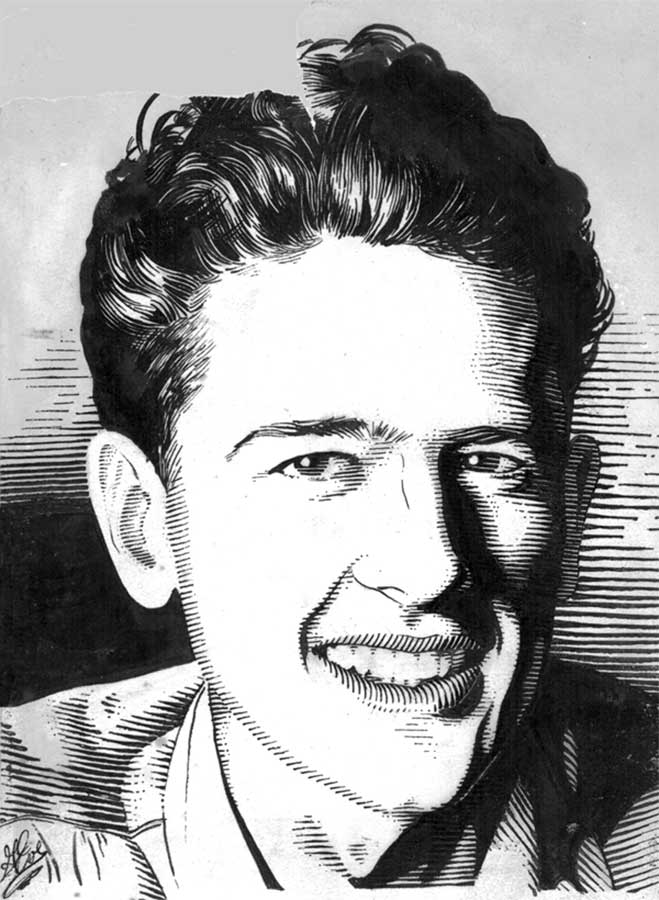In the summer of 1942, the U.S. Army called up a skinny California boy a barely out of his teens. But at 5’9’’ and 125 pounds, Private Glenn W. Eve was deemed unfit for combat.
He might have spent the duration of World War II behind a desk, but he had field skills the Army needed—he was a gifted artist, draftsman, and photographer who’d spent the previous four years working for the Walt Disney Co.
In July 1944, they promoted him to private first class (Pfc) and assigned him to the Signal Photo Corps, bound for the Pacific to document the engagement. All comments in quotes under the images are Pfc Eve’s, written on the back of the photo.
What makes this war archive unique is the number of cultural images included. Pfc Eve had a “National Geographic” photographer’s eye for capturing the people and places affected by conflict. It’s also one of the few repositories that details Gen Spencer Akin’s ground-breaking Mobile Photo Lab experiment.
Although Pfc Eve shot many of the images herein, the iconic ones, such as those with Gen MacArthur, were likely just developed by him while working in the Mobile Photo Lab. I credit the original photographer where possible, but many of their names have been lost in time.
Chronology
New Guinea (August-October 1944): In August 1944, Pfc Eve shipped out from San Francisco for New Guinea, and spent almost three months there.
Philippines (November 1944-August 1945): In October 1944, American liberation forces landed in the Philippines. Pfc Eve moved from New Guinea to Tacloban, Leyte Island, a port city approximately 360 miles southeast of Manila. There, he joined the staff of General Akin’s experimental Mobile Photo Laboratory, which had been built into the 34-foot long van of a semi-trailer vehicle.
In January 1945, the Mobile Photo Lab Unit sailed for Luzon Island on an LST (tank landing ship). In March 1945, often under fire, they advanced into Manila. The Mobile Photo Lab Unit eventually set up inside the Sampugita Pictures Company building. (See Mobile Photo Lab History.)
Japan (August-November 1945): In August 1945, Emperor Hirohito surrendered. Pfc Eve and the Mobile Photo Lab Unit relocated to Tokyo with the allied occupation forces. They remained until November 30.
You can follow Pfc Eve’s route with the Mobile Photo Lab on this map.
Two of my best friends, Johnson & Quon. Philippines 3/3/45.

Curator’s Notes
For some reason, as a young girl, I became the repository for the war stories of my father, Pfc Glenn Eve. (My sister Lisa got his artistic talent.)
In 1966, I was seven years old. The war was more than twenty years behind my father, but as fresh as yesterday in his memories. I listened and tried to understand.
He often talked about his friend Quon. He stood by Quon when ignorant comrades called him “Jap” and “traitor.” They were two outsiders against the world—the Chinese-American and the skinny artist with the sissy surname. Can you imagine the hell my dad went through in the Army, where everyone called you by your last name? On the back of a remarkable portrait of his friend by match light, just one word… “Quon!” The exclamation point makes it so poignant.
Sometimes he wondered what happened to Johnson, a Southern boy with a biting sense of humor, often depicted barefoot and/or shirtless and smiling in these photos, once with a monkey on his chest. My father smiled, too, when he thought of Johnson.
He was starstruck by an encounter with famous war correspondent Ernie Pyle and was disheartened by Pyle’s death. He felt it symbolic the photo unit shipped home on the S.S. Ernie Pyle.
Before the war, my father was an animator for Walt Disney Co. They discovered him at age 16 when he won a drawing contest. He dropped out of school to work for Disney and apprenticed on Fantasia.
In those days, an apprentice animator’s job involved unbelievable repetition, each small gesture sketched a hair’s breadth beyond the preceding one. They got the cartoon grunt work. He often found it frustrating, but as he graduated onto larger projects, it became his life.
Disney decided not re-hire him after the war and it broke his heart. As a high school dropout artist, it became harder and harder for him to find work. He was often unemployed. Sometimes he drank.

My father passed away in 1994, a broken man. I believe he suffered all his adult life from post-traumatic stress disorder, which only gained widespread recognition after Viet Nam.
He bequeathed these photos to me and said, “Do something with them.” I’m ashamed to admit that they sat in the same 60-year-old box until last year when I transferred them to archival sleeves. Many crumbled when I removed them for scanning.
How many of these photos did he take and how many circulated as mementos among the photo battalion members? It’s hard to say. I’ve traced the most recognizable ones to MacArthur’s personal photographer, Staff Sergeant Charles Restifo, and have credited him.
But I can see my father’s special humanity in many images. I know he took all the portraits of children, animals, and pretty girls (he was just out of his teens, after all). Also, the shots of nature, sunsets, and the countryside. These were things he loved.
In 2010, Steven Spielberg’s HBO epic The Pacific finally provided the impetus for organizing and publishing this collection. It’s a fitting time to contribute another chapter to the “forgotten war.” We can thank the Signal Photo Corps for the fact that we have any footage at all from this momentous period.
If you recognize anyone or anything I couldn’t place, I’d love to know via the contact form below.
If you would like to use these photos, please credit The Pacific War Photos of Pfc Glenn W. Eve. They are made available under a Creative Commons Attribution-Noncommercial-No Derivative Works 3.0 Unsupported License.
Debra Eve
Los Angeles, California
October 2010
